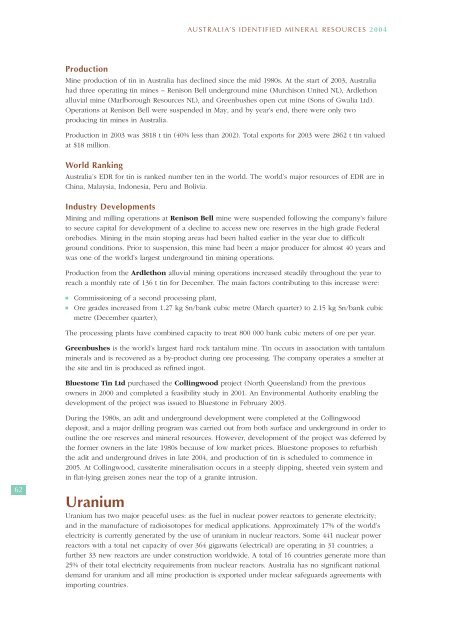australia's identified mineral resources 2004 - Geoscience Australia
australia's identified mineral resources 2004 - Geoscience Australia
australia's identified mineral resources 2004 - Geoscience Australia
Create successful ePaper yourself
Turn your PDF publications into a flip-book with our unique Google optimized e-Paper software.
AUSTRALIA’S IDENTIFIED MINERAL RESOURCES <strong>2004</strong><br />
Production<br />
Mine production of tin in <strong>Australia</strong> has declined since the mid 1980s. At the start of 2003, <strong>Australia</strong><br />
had three operating tin mines – Renison Bell underground mine (Murchison United NL), Ardlethon<br />
alluvial mine (Marlborough Resources NL), and Greenbushes open cut mine (Sons of Gwalia Ltd).<br />
Operations at Renison Bell were suspended in May, and by year’s end, there were only two<br />
producing tin mines in <strong>Australia</strong>.<br />
Production in 2003 was 3818 t tin (40% less than 2002). Total exports for 2003 were 2862 t tin valued<br />
at $18 million.<br />
World Ranking<br />
<strong>Australia</strong>’s EDR for tin is ranked number ten in the world. The world’s major <strong>resources</strong> of EDR are in<br />
China, Malaysia, Indonesia, Peru and Bolivia.<br />
Industry Developments<br />
Mining and milling operations at Renison Bell mine were suspended following the company’s failure<br />
to secure capital for development of a decline to access new ore reserves in the high grade Federal<br />
orebodies. Mining in the main stoping areas had been halted earlier in the year due to difficult<br />
ground conditions. Prior to suspension, this mine had been a major producer for almost 40 years and<br />
was one of the world’s largest underground tin mining operations.<br />
Production from the Ardlethon alluvial mining operations increased steadily throughout the year to<br />
reach a monthly rate of 136 t tin for December. The main factors contributing to this increase were:<br />
■<br />
■<br />
Commissioning of a second processing plant,<br />
Ore grades increased from 1.27 kg Sn/bank cubic metre (March quarter) to 2.15 kg Sn/bank cubic<br />
metre (December quarter),<br />
The processing plants have combined capacity to treat 800 000 bank cubic meters of ore per year.<br />
Greenbushes is the world’s largest hard rock tantalum mine. Tin occurs in association with tantalum<br />
<strong>mineral</strong>s and is recovered as a by-product during ore processing. The company operates a smelter at<br />
the site and tin is produced as refined ingot.<br />
Bluestone Tin Ltd purchased the Collingwood project (North Queensland) from the previous<br />
owners in 2000 and completed a feasibility study in 2001. An Environmental Authority enabling the<br />
development of the project was issued to Bluestone in February 2003.<br />
62<br />
During the 1980s, an adit and underground development were completed at the Collingwood<br />
deposit, and a major drilling program was carried out from both surface and underground in order to<br />
outline the ore reserves and <strong>mineral</strong> <strong>resources</strong>. However, development of the project was deferred by<br />
the former owners in the late 1980s because of low market prices. Bluestone proposes to refurbish<br />
the adit and underground drives in late <strong>2004</strong>, and production of tin is scheduled to commence in<br />
2005. At Collingwood, cassiterite <strong>mineral</strong>isation occurs in a steeply dipping, sheeted vein system and<br />
in flat-lying greisen zones near the top of a granite intrusion.<br />
Uranium<br />
Uranium has two major peaceful uses: as the fuel in nuclear power reactors to generate electricity;<br />
and in the manufacture of radioisotopes for medical applications. Approximately 17% of the world’s<br />
electricity is currently generated by the use of uranium in nuclear reactors. Some 441 nuclear power<br />
reactors with a total net capacity of over 364 gigawatts (electrical) are operating in 31 countries; a<br />
further 33 new reactors are under construction worldwide. A total of 16 countries generate more than<br />
25% of their total electricity requirements from nuclear reactors. <strong>Australia</strong> has no significant national<br />
demand for uranium and all mine production is exported under nuclear safeguards agreements with<br />
importing countries.

















